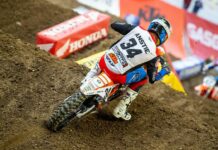The new cycle for KTM’s all-conquering SX-F motocross range is coming into view and the factory Red Bull squad will play a key role by potentially running pre-production 2016 machinery during the 2015 FIM Motocross World Championship.
The 250SX-F has owned the MX2 category since 2008 and Tony Cairoli’s union with the Austrians at the end of 2009 means that the 350SX-F has been the championship bike in the premier class ever since. Another small piece of trivia: Ben Townley became the very first rider to win MX2 and MX1 Grands Prix when he claimed spoils on the 250SX-F in 2004 and then on the 450SX-F in 2005.
“For a couple of years we have been working really closely with the R&D department and that has brought us onto a successful road,” reveals KTM Sport Director Pit Beirer. “We are developing a new generation of motocross bikes with them. For the work that we put in we get the payback in that we are the first guys to use these bikes.”
“I would not really call it a prototype and it is not 100% decided yet but I’m pretty sure that we will run the 2016 standard model in 2015,” he continued on KTM’s possible technical plans. “Of course to everybody here [the MXGP paddock] it will be a prototype but for us it is just part of the process of there being a more radical step in the bike development every couple of years. It is across the SX-F board. It is not a new concept, just a new KTM and every three years we try to push harder and higher.”
KTM are free to play at will in MXGP with the regulations suiting prototype development and granting a decent margin of liberty for the manufacturers. In the USA however the AMA restrictions are tighter when it comes to a production base and, considering the importance of a booming market for the Orange camp over the Atlantic, this requires a different plan.
“In America we were forced to have a production bike that is at the level to win at supercross but that helps to make your whole product better,” Beirer expands. “There is no room or excuses for using things like a prototype frame. We had to learn hard to be competitive at that level but it made us better and the market is responding to that.
“In Europe we already had a good portion [of the market] but in America we were under observation and since we are a proven race winner in the SX premier class the market has been on fire. We’ve increased by 20% every year in total in KTM and that’s because we are seen in the stadiums by 50,000 people and on TV winning. We are not winning every race but we are competitive brand against the four Japanese and people respect that we are fighting against them.”
“For me it is a very important development because without a signal from the market then racing is not needed at the level we have it in the U.S. So I can prove with projects like Cairoli with the 350 and the whole American set-up that the board can invest in racing. I’m happy that they are all behind me and we can do such a good job.”









